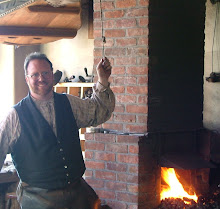
Learning the shapes of useful tools and the tricks of creating forged shapes can be a challenge for blacksmiths. This book is a wonderful resource to help blacksmiths learn these skills from a talented German smith. Wasmuth’s book on Schmirler’s work is written in German, French, and English. It is beautifully illustrated with photos and with colored sketches of hammers, punches, and the ironwork created with them.
The Smithy’s Craft and Tools provides an excellent window into a traditional German blacksmith’s shop and reveals his tools and work.
This book may be hard to find, but is
available.
Wasmuth, “Otto Schmirler Werk und Weerkzeug des Kunstschmieds, The Smith’s Craft and Tools,” ca 1981. (Reprinted in 1993) Tubingen, Germany.
 Another project underway is a Suffolk-style door handle and latch for the Doctor’s Office. It’s not done yet, but will be in a day or two. There are more projects to do after that. Keep looking to see a report on the continued repair of the wooden beam plow!
Another project underway is a Suffolk-style door handle and latch for the Doctor’s Office. It’s not done yet, but will be in a day or two. There are more projects to do after that. Keep looking to see a report on the continued repair of the wooden beam plow! 


 Blacksmith-made shoes are forged and are made to exactly fit each foot of the horse. Since all four feet of the horse are different, the shoes will be slightly different as well. There may be custom features like varied placement of the nail holes, special caulks or “corks” to provide traction in mud or snow, or modifications to strengthen the horses feet.
Blacksmith-made shoes are forged and are made to exactly fit each foot of the horse. Since all four feet of the horse are different, the shoes will be slightly different as well. There may be custom features like varied placement of the nail holes, special caulks or “corks” to provide traction in mud or snow, or modifications to strengthen the horses feet.









 Where do our Cayuga ducks go when it rains? Anywhere they want! They spend part of each day in the pond, even when there is ice in the water. They spend the rest wandering around looking for something tasty to eat. Just after seeing the chickens roosting in the barn I spied the ducks wandering up the farm field road looking for worms or new tender shoots. They were muttering and quacking as they walked and seemed to be having a great time.
Where do our Cayuga ducks go when it rains? Anywhere they want! They spend part of each day in the pond, even when there is ice in the water. They spend the rest wandering around looking for something tasty to eat. Just after seeing the chickens roosting in the barn I spied the ducks wandering up the farm field road looking for worms or new tender shoots. They were muttering and quacking as they walked and seemed to be having a great time.

 We have bolt tongs that hold round stock securely.
We have bolt tongs that hold round stock securely. Box-jaw tongs hold square or rectangular stock in an iron grip.
Box-jaw tongs hold square or rectangular stock in an iron grip. Hammer-eye tongs are used to hold a hammer head by the eye while it is forged to shape.
Hammer-eye tongs are used to hold a hammer head by the eye while it is forged to shape.  The blacksmith is a tool maker, so we can make tongs to suit our work. Having well-fitted tongs makes our work safer and better.
The blacksmith is a tool maker, so we can make tongs to suit our work. Having well-fitted tongs makes our work safer and better.





